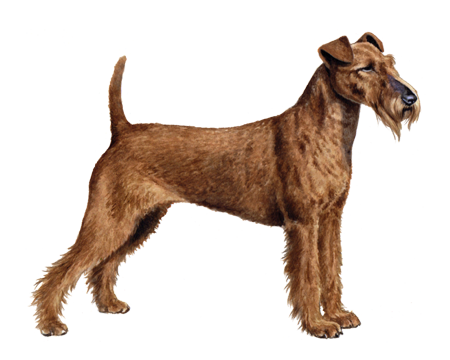
Border Terrier
Border Terriers are energetic, intelligent, and alert dogs. Their friendly and affectionate nature makes them a welcome addition to any household.
Interested in discovering if your dog is a Border Terrier?
Check out Wisdom Panel's DNA tests.

Border Terrier Traits
General Appearance
Border Terriers are medium-boned dogs with narrow shoulders, short, muscular necks, and brawny hindquarters.
Coat and Colouring
The Border Terrier’s coat comes in either red, tan and grizzle (black hairs in the coat), or wheaten. Combinations of these colors, black points, and black masks are also possible.
Distinctive Physical Traits
Border Terriers have a characteristic otter-like head that’s relatively broad and flat. Their ears are small and V-shaped.
Border Terrier Temperament
Border Terriers are happy-go-lucky, social dogs that provide their people with endless entertainment. They’re good with kids and friendly toward other dogs. But because of their background as small animal hunters, they may chase little pets and wildlife. For the same reason, this breed also tends to bark and dig.
Border Terriers are diligent workers and good-tempered, affectionate companions at home.


Border Terrier History
The Border Terrier originated in the borderlands that separate England and Scotland in the early 18th century. Farmers used these scrappy little dogs for ratting in the barn and hunting hill fox.
When hunters went after a fox, these dogs accompanied them and chased foxes down into their underground dens. Border Terriers also proved to be skilled at hunting otter, rabbit, and badger. Hunters could identify where their Border Terriers were by listening for their barking.
Over time, the breed became a popular family pet. The American Kennel Club officially recognized the Border Terrier 1930.
Border Terrier Care
Nutrition
Border Terriers need a high-quality dog food that is age-appropriate—whether it’s commercially manufactured or homemade (under a veterinarian’s supervision and approval).
Some dogs are prone to becoming overweight. It’s important to monitor the amount of food you give them and reduce portions if your pup gains weight. Also, keep in mind that giving too many treats in addition to regular meals can contribute to obesity.
Grooming
Like most double-coated breeds, Border Terriers shed seasonally. Most of the year, a quick brushing every week or two keeps their coats in tip-top condition. But during seasonal shedding periods, plan on a daily 30-minute session to strip out dead hair.
You can skip the bath, though. The Border Terrier’s coat naturally repels dirt, and bathing actually impairs this ability.
Overgrown nails can lead to pain or issues walking. So, trim regularly to keep them at an appropriate length.
Exercise
Border Terriers love being outdoors, and many activities make them happy pups. Vigorous backyard play sessions, romps in the yard, and brisk walks are all great ways to provide needed exercise.
But remember, this breed is hardwired to chase small animals. So, time outside should be in an enclosed area or on a leash.
Border Terriers also seem to enjoy dog sports such as agility, tracking, flyball, rally, and competitive obedience.
Training
Border Terriers are eager to learn and respond well to reward-based training using their favorite treats. Gentle training—rather than a harsh approach—works best for this breed.
Puppy training classes and early socialization help all dogs get off to a good start. Exposing Border Terriers to as many people and situations as possible when they’re young helps them develop into well-adjusted adult dogs.

Border Terrier Genetic Health Conditions
-
Shaking Puppy Syndrome (Discovered in the Border Terrier)
Spongiform LeucoEncephaloMyelopathy (SLEM) is a disorder commonly known as shaking puppy syndrome. Affected pups show severe body tremors, which are generally first noted when the puppy begins to try to walk.
Knowing if your Border Terrier is a carrier or at-risk for these conditions can help you and your veterinarian plan for your pup's lifelong care. With Wisdom Panel™ Premium, you can get results for over 200 genetic health tests.
Breed Group
Terrier
The Terrier Group ancestors were bred to hunt and kill vermin. They are often characterized as feisty and energetic dogs whose sizes range from fairly small to much larger.
Resources
https://www.akc.org/dog-breeds/border-terrier/
Reviewed 26 July 2020 by Cindy Elston, DVM, MPH





















































